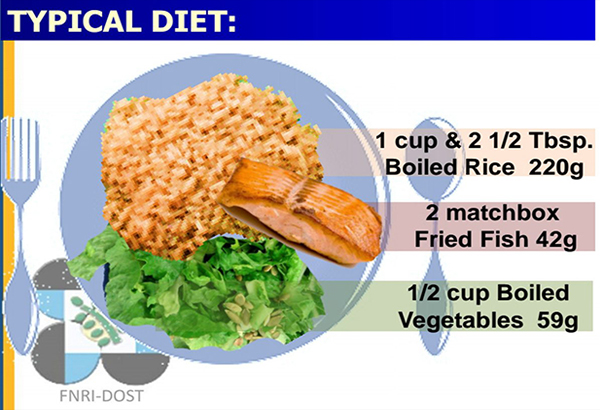Pinggang Pinoy: Nutrition guidelines for every Juan
What’s on the plate of the typical Pinoy diet? Are Filipinos eating more or eating less?
For the answers to these absorbing questions and more, we sink our teeth into the global and local nutrition survey results presented by Divorah Vinluan Aguila, senior science research specialist, Food & Nutrition Research Institute, Department of Science and Technology, at a recent forum held in Makati.
“We’re mandated to define the nutritional status of Filipinos and we’re doing this nationwide survey every five years,” Divorah discloses. “The Senate is proposing we do it every year, but we don’t have the budget to conduct the survey which will entail millions.”
The survey covers how many are overweight and underweight, the dietary, food consumption component, and then the biochemical, how many are anemic and where are they located.
The last survey was held in 2013, the most comprehensive so far.
Survey Says

The survey says the typical Pinoy diet consists of: a cup and 2-1/2 Tbsps. of boiled rice (220g), two matchbox-size fried fish (42g), and 1/2 cup boiled vegetables.
What sort of fish?
“Before, it was galunggong (GG, as we fondly call it),” says Divorah. “But because the price of galunggong has gone up (since the time of President Cory Aquino when this poor man’s fish was the most tangible economic indicator), it has been replaced by tilapia or bangus for the average Filipino. In some regions, bangus is cheaper.”
What’s the typical serving of rice in the Pinoy diet? Think McDo rice serving. No unli rice, please!
And what’s in the half cup of veggies? In there could be carrots, malunggay, eggplant, tomato, or what you would normally see selling in bundles in the wet market like malunggay or kangkong.
What about spinach?
Well, that’s just for Popeye and the wide-eyed affluent!
“Only 35 percent or more than 1/3 of Filipino households meet their energy requirements,” Divorah shares. “So the 2/3 are at a loss, they’re not meeting their requirements for energy.”
For protein, almost 60 percent of Pinoy households (now that’s quite a meaty chunk) are meeting their requirement. Also niacin, which is inherent in rice, as well as thiamine.
Brown Is Beautiful

Did you know that FNRI was able to develop a technology to increase the shelf life of brown rice from three to nine months, enough to convince farmers to produce brown rice?
Brown rice is healthier than white rice because it’s got all its nutrients still intact (B vitamins, lipase/lipid or fatty acids) while white rice has lost its nutrients due to the processing.
Divorah gives us this take-home message: No single food can provide us with all the needed nutrients our body demands in order to live life to the fullest.
She adds, “The food pyramid is a snapshot of our requirement in a day. But people are confused and they keep asking if we’re supposed to eat all that in one sitting. That’s why we developed this (the Go, Grow, Glow plate). This is not intended to replace the pyramid but to support, supplement it. This is per mealtime. The pyramid is for a day.”
You may ask: What if I don’t have a serving of fruit and vegetable?
Divorah replies, “I will throw back the question to you: If we will only eat ulam and rice, do you think you will not overeat to fill up your energy requirement?”
She elaborates, “The reason we’re eating is we want to achieve the feeling of fullness. Di tayo kumakain para wala lang. But so that our obesity/overweight problem will not skyrocket, we should learn proportion. Although it’s okay to have ulam, we need to observe moderation and balance. We are not supposed to exceed our requirement.”
Take A Hike
The second — and just-as-important — part of this survey is physical activity. “It doesn’t mean we need to enroll in a gym,” says Divorah. “We can integrate or incorporate physical activity or a healthy lifestyle by doing even those household chores (while getting our house cleaned, we also don’t have to clean our pockets by enrolling in an expensive gym). The recommendation is 30 to 35 minutes of moderate physical activity. But for those who cannot do the 30 minutes in one shot, you can divide it into 10s or 15s — one in the morning and another in the evening. It teaches us behavior modification. Brisk or leisure walking is also okay.”
While watching your waistline, here’s the bottom line: Good nutrition pays.
“Good nutrition is multi-faceted just as malnutrition is,” Divorah asserts. “Our BMI (body mass index) is right, our minds are free of stress (our emotions should be okay, too), we don’t have any sickness or disease.”
Lite Is Right
 Nutrilite assistant brand manager Mia Jamisola, at a recent media forum, discussed phytonutrients and supplementation, and how these can help bridge the nutritional gaps of Filipi-nos. Nutrilite supplements are made by combining the vitamins, minerals, and phytonutrients from over 170 plants.
Nutrilite assistant brand manager Mia Jamisola, at a recent media forum, discussed phytonutrients and supplementation, and how these can help bridge the nutritional gaps of Filipi-nos. Nutrilite supplements are made by combining the vitamins, minerals, and phytonutrients from over 170 plants.FNRI and Nutrilite have partnered to promote the right nutrition for everyone.
Nutrilite is the world’s leading brand of dietary vitamins and supplements. “Our Nutrilite supplements contain phytonutrients that are from the five colors (more on this a wee bit later),” says Mia Jamisola, assistant product manager for Nutrilite. “Phyto comes from the word plant with nutrition-enabling substances. According to FNRI and WHO (World Health Organization), we need five to nine servings of fruits and vegetables daily. Even me, I can’t have that. We’re guilty of this. And for those servings, you need a variety, not just white or green fruit or vegetable because a certain color refers to a certain nutrient — white for bone and joint health, red for heart health, purple for brain health, orange for eye health, green for cellular health.”
Mia is happy to add, “We have beverages that you can take as a meal replacement. As a replacement for your dinner, but we still advise everyone to take breakfast and lunch.”
According to Mia, if we were to choose one product or supplement that would cover everything, fill the gap between what we actually need vs. what we actually take, she is recommending the Nutrilite Double X, Nutrilite’s core product.
The ultimate dietary supplement, Nutrilite Double X has 11 vitamins, nine minerals, and 12 plant concentrates.
Nutrilite has assorted products to cater to people’s assorted needs: omega 3 complex, protein drink mix, all plant protein powder, natural multi-carotene, natural B complex, nutri fiber blend chewable tablets for healthy aging, vision health with lutein, kids chewable vitamins and minerals, Body Key meal replacement shake for weight management, and the list goes on (available at Amway distribution centers, visit www.amway.com.ph).
Listen Up, Every Juan!

The Food & Nutrition Research Institute has a mouthful to say about what every Juan (and Juana) should eat (or do) for optimum health. Here are the nutritional guidelines for Filipinos:
1. Eat a variety of foods every day to get the nutrients needed by the body.
2. Breastfeed infants exclusively from birth up to six months, then give appropriate complementary foods while continuing breastfeeding for two years and beyond for optimum growth and development.
3. Eat more vegetables and fruits every day to get the essential vitamins, minerals, and fiber for regulation of body processes.
4. Consume fish, lean meat, poultry, egg, dried beans or nuts daily for growth and repair of body tissues.
5. Consume milk, milk products, and other calcium-rich foods, such as small fish and shellfish, every day for healthy bones and teeth.
6. Consume safe foods and water to prevent diarrhea and other food- and water-borne diseases.
7. Use iodized salt to prevent iodine deficiency disorders.
8. Limit intake of salty, fried, fatty, and sugar-rich foods to prevent cardiovascular diseases.
9. Attain normal body weight through proper diet and moderate physical activity to maintain good health and help prevent obesity.
10. Be physically active, make healthy food choices, manage stress, avoid alcoholic beverages, and do not smoke to help prevent lifestyle-related non-communicable diseases.
So, every Juan, let’s go, grow, and glow!



















